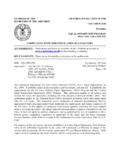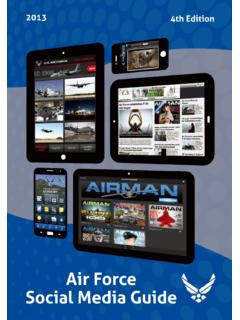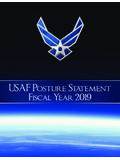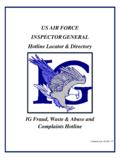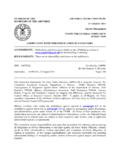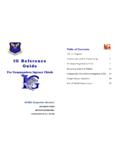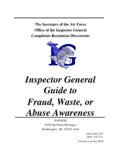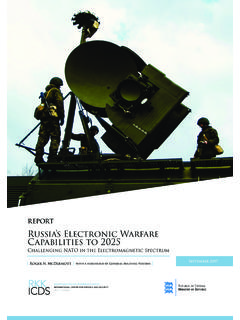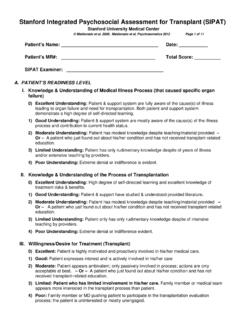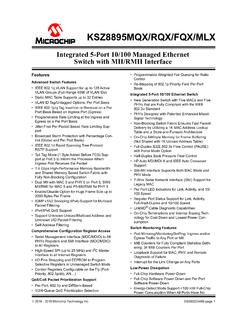Transcription of Air Superiority 2030 Flight Plan - AF
1 Air Superiority 2030 Flight PlanEnterprise Capability Collaboration Team May 2016 BACKGROUNDThe Chief of Staff of the Air Force chartered the Air Superiority 2030 (AS 2030) Enterprise Capability Collaboration Team (ECCT) to develop capability options to enable joint force Air Superiority in the highly contested environment of 2030 and beyond. CSAF-chartered ECCTs bring users and operators from all Air Force domains and core functions together with the requirements, acquisition, and Science & Technology (S&T) communities. These experts collaboratively examine, comprehend and quantify operational needs, including current and emerging capability gaps that span the Air Force enterprise.
2 As part of the Air Force capability development process, ECCTs formulate and explore innovative multi-domain options for mate-riel and non-materiel solutions that may wholly or partially mitigate capability gaps or provide opportunities for greater effectiveness and efficiency. Optimizing investments requires a full and integrated understanding of Air Force capabilities and missions in order to ensure the Air Force fulfills joint warfighting requirements. AIR SUPERIORITYC ounterair operations are designed to gain control of the air and wrest such control away from an adversary.
3 Air Superiority is a condition on the spectrum of air control, which ranges from adversary air supremacy, to air parity, to friendly air supremacy. The air Superiority condition is achieved when friendly operations are able to proceed without prohibitive interference from opposing forces. In modern military operations, achieving this level of control of the air is a critical pre-condition for success. Air Superiority provides freedom from attack, freedom to attack, freedom of action, freedom of access, and freedom of awareness. Importantly, it also precludes adversar-ies from exploiting similar advantages.
4 As such, air Superiority underwrites the full spectrum of joint military operations and provides an asymmetric advantage to friendly forces. A lack of air Superiority significantly increases the risk of joint force mission failure as well as the cost to achieve victory both in terms of resources and loss of life. In common discourse, air Superiority is often envisioned as a theater-wide condition. In highly contested environments, such a conception may be unrealistic and unnecessary. Air Superiority is only needed for the time and over the geographic area required to enable joint operations.
5 The specific amount of time and space required varies significantly across scenarios, mission objectives, and phases of conflict. Accordingly, capability development for air superior-ity must provide options for commanders to array their forces across a range of durations and geographies. AIR SUPERIORITYTHE 2030 OPERATIONAL ENVIRONMENTE merging integrated and networked air-to-air, surface-to-air, space and cyberspace threats, as well as aging and shrinking fleets of US weapon systems, threaten the Air Force s ability to provide air Superiority at the times and places required in the highly contested operational environments of 2030 and beyond.
6 Threat capabilities are likely to advance along two major vectors over the next 15 years. First, traditional threat systems will continue to evolve and proliferate. Along this threat vector are advanced fighter aircraft, sensors, and weapons. While near-peers have most of these capabilities today, advanced air and surface threats are spreading to other countries around the world. Air Superiority forces will face growing numbers of these threats across a wide range of locations and scenarios in 2030. The second threat vector is a series of comprehensive capabilities with a less predict-able impact on warfare.
7 These include increased threat capabilities to negate our advantages in the space domain, increased quantity and sophistication of cyberspace threats, and air threats including hypersonic weapons, low observable cruise missiles, and sophisticated conventional ballistic missile systems. How, when and where these capabilities emerge is less clear, but it is certain air Superiority forces will face many of these threats by 2030. The Air Force s projected force structure in 2030 is not capable of fighting and winning against this array of potential adversary capabilities.
8 Developing and delivering air Superiority for the highly contested environment in 2030 requires a multi-domain focus on capabilities and capacity. Importantly, the rapidly changing operational environment means the Air Force can no longer afford to develop weapon systems on the linear acquisition and development time-lines using traditional approaches. Air Superiority capability development requires adaptable, affordable and agile processes with increasing collaboration between science & technology (S&T), acquisition, requirements and industry professionals. Failure to adopt agile acquisition approaches is not an option.
9 The traditional approach guarantees adversary cycles will outpace development, resulting in late-to-need delivery of critical warfighting capabilities and technologically superior adversary ENVIRONMENTPROCESSThe AS 2030 team began its efforts by characterizing the 2030 threat environment. Following problem definition, the ECCT examined friendly and adversary mission effects chains, re-viewed capability gaps, conducted a comprehensive review of existing classified and unclassified analysis and reporting, and assessed promising technologies and other opportunities.
10 This led to a concept collection phase with over 1,500 different concepts submitted and evaluated based on technical readiness level, gap mitigation, cost, and level of dependencies. Following concept collection, the ECCT entered the analysis phase. During this phase the team leveraged existing analytical products and conducted independent modeling, simulation, and wargaming. The team used detailed assessment criteria to ascertain effectiveness at the engagement, mission, and campaign levels, and assessed force structure level impacts. The ECCT s analysis phase culminated in the development of strategic level courses of action (COAs) for senior leader consideration.
